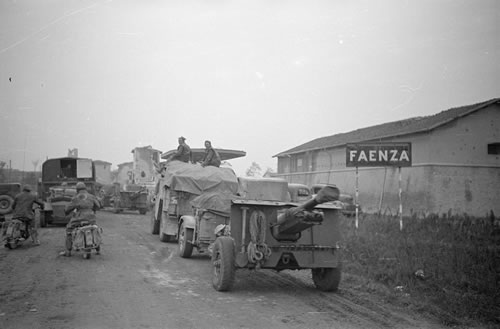Italian Campaign
Faenza
The 2NZEF saw action in and around Faenza and the Senio River from November 1944. By April 1945 they had broken through the German defences and by May had moved on to Trieste. (click on image for full campaign map)
Campaign memories: Faenza, Reg Minter
Private Reg Minter, 620068, went to the Middle East with the Tenth Reinforcements in July 1943. He joined 24 Battalion as a signalman and went to Italy in late December 1943. His first real time in action was at Cassino in March 1944 where he was wounded. After six weeks in 2 New Zealand General Hospital, Reg rejoined the battalion and fought on up through Italy where the New Zealand Division had to take the town of Faenza, and break through the German lines on the Senio River.
![]() Hear Reg
Minter discussing
his experiences at Faenza (mp3,
1.15mb)
Hear Reg
Minter discussing
his experiences at Faenza (mp3,
1.15mb)
Transcript
'On the other side was Faenza, the town of Faenza. That, round that area got quite a bit of fighting off and on. Skirmishes and things like that. We were in a holding position for a while, while 22 Battalion did an attack around, around sort of a pincer movement round Faenza. They had quite a few casualties there. And then we got mostly round Faenza—actually, we encircled it in the finish—not only us but other battalions, I think 25 did. They encircled it.
The battalion—A Company, B Company, three of its companies—I think D was left in reserve—got as far as the railway line. Well, the railway line was on a bank about ten feet above ground level, in this particular area. And we got into a big house, just, just, just this side of the railway line. And there was a small road, country road running up towards a lot of farmhouses on the flat. It was quite flat. And we had to do an attack that night to take two or three houses, and our other companies on our left were doing the same. They had objectives to take—different houses. And we probably gained about two thousand yards, something like that.

Artillery on the move into Faenza, with gun, limber and quad.
Alexander Turnbull Library, War History Collection, DA-07966
It was a silent attack. It wasn't, we didn't go in a barrage, it was a silent attack. We were supposed to have some tanks for this. Just before I got there, the, we had to move up to this place, and one of our platoons got caught badly in mines because we were going up at night. I had to call the battalion for some ambulances which they did. However we went up, left this house, went, climbed up over the railway line and went up towards these buildings. I suppose the first lot was about a thousand yards away. We were climbing up there and there was hawthorn hedges going laterally with us. And the Germans—in our area the Germans had two fixed lines. I don't know why, but they always seemed to like to fire on fixed lines, and they used a lot of tracer. So we walked between the tracers. Mind you, it was close. I didn't feel very happy doing it but we walked between the lines of tracer. He wasn't firing all that, but now and again he'd give bursts. And the platoons in front of us were doing the same.
Anyhow, everything went quite well. The platoon got to the first house, nothing there. It went to another small house, about fifty, sixty yards ahead. Nothing. So we, the first house Major Howden made that our Company Headquarters, and about, and about another four or five hundred yards up further, a platoon took a house, took a couple of prisoners then, out of the blue, the Germans brought a tank in and our guys had to, had to get out quickly. Our tanks couldn't get through because where the road went underneath the railway line, like a small viaduct, they'd blown it and mined it, so they had to get the Engineers to clear all the mines before our tanks could get, could help us. This would be about twelve hours before that happened.
So, next thing we know … Jack Price came back—he was the 2nd Lieutenant of 7 Platoon … he said, "We've been driven out, sir. … We've left four or five guys up there, wounded. We couldn't bring them out." Major Howden said, "We've got nothing here to fight the tanks, so we'd better get out." So we had to go too.
He was mortaring us as we—actually we retreated. We had to go back to where we started from. When we got back to the railway, back to the house we came, looking a bit worse for the wear because we had to go through these hawthorn hedges. We looked like cats had been scratching at us.
Then one of our medical guys … stayed up there with our guys. … Our other medic, he said to Major Howden, "Look sir, I think I'd better go up and help the guys." Howden said, "You know you'll be POW." He said, "Oh well. I have to go and see if they're all right." So he went up too. I saw him after the war because he was taken prisoner. He got the MM for that. Evidently two or three guys were badly hurt.'

A New Zealand Divisional Signaller makes contact by telephone near Faenza, December 1944.
Alexander Turnbull Library, War History Collection, DA-07969
Next: Trieste >
